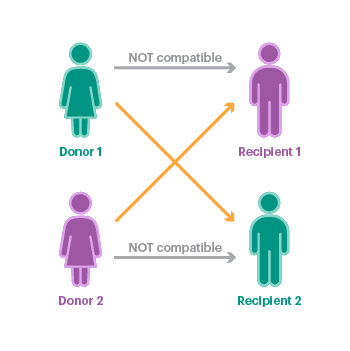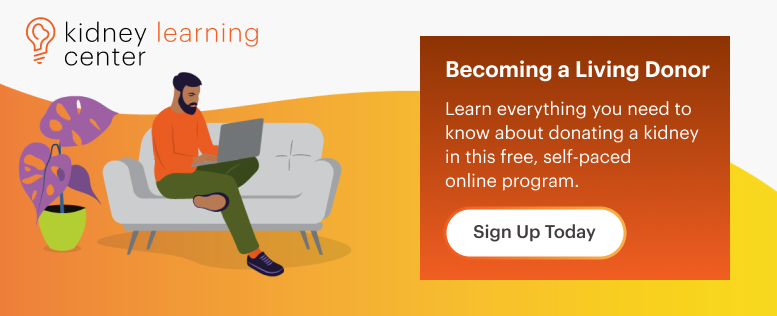
Programs for Donor/Recipient Pairs with Incompatible Blood Types
Kidney Paired Donation
Sometimes a donor will want to donate to a recipient, but they’re not compatible, or a good match. This can be due to not having a compatible blood type, antibody levels or other reasons. Some transplant centers will help incompatible pairs of recipient/donors through a process called Kidney Paired Donation, or Paired Exchange, which involves two living donors and two recipients.
If the recipient from one pair is compatible with the donor from the other pair, and vice versa– the transplant center may arrange for a "swap"–for two simultaneous transplants to take place. This allows two transplant recipients to receive living donor kidneys and two donors to still be able to donate, though the original recipient/donor pairs were unable to do so with each other.

Figure 1: In paired exchange, an incompatible donor/ recipient pair (such as a mother and son that don't have compatible blood types) are matched with another incompatible donor/recipient pair for a "swap". Each donor gives a kidney to the other person's intended recipient.
There are many different ways these types of donations can occur. The most common way is when both donors donate on or around the same day; giving the other donor’s recipient their kidney. If the incompatible pairs end up being in a chain, where there are more than 2 donors and 2 recipients, they might donate and receive kidneys around the same time, but not necessarily on the same day. Being in a chain allows more people needing a kidney, to receive a living donor transplant. See below graphic for more information.
There are also other donation programs through the National Kidney Registry that allow donors to do “Remote Donation” which allows them to donate to their donor or any other donor, closer to their home and their kidney is then sent to their recipient’s center to transplant. Another program is “Advanced Donation” which allows a donor to donate on their schedule; giving their recipient a voucher for another living donor kidney, when they’re ready for one.
You can visit the NKR website to see which transplant centers participate in these programs.
Never Ending Altruistic Donor (NEAD) chain
A NEAD™ chain (Never Ending Altruistic Donor chain) begins with one non-directed (altruistic) potential donor. In this program, the non-directed donor gives to a person waiting for a transplant, and that recipient's willing – but incompatible – donor gives to another person waiting, and so on.
Each living donor in this system gives to a stranger, and the chain of donors is kept going as long as possible.
Figure 2:
In A NEAD™ chain, a non-directed potential donor is matched up with a recipient who has a willing, but incompatible donor. Then that recipient's incompatible donor then gives to another incompatible pair, and so on.

For More Information
If you are interested in one of these exchange programs:
Talk with your transplant hospital. If you're already working with a transplant hospital: Talk to them about your options. Ask them if any of these programs are an option for your situation, and if so, does that hospital offer them?
- If not: contact transplant hospitals (in the recipient's area) to ask. To find a transplant center in your area click here. Select "transplant center by organ," then select "kidney," and then select your state.
- Contact a transplant hospital that has an exchange program. It's always a good idea to check with your transplant hospital, or hospitals nearby.
- Contact other organizations which might help. Following are links to other organizations which help to facilitate exchanges.(Note: these organizations and their websites are not under the control of the NKF, and NKF assumes no responsibility for their content or services. These links are provided for information purposes only, and should not be considered an endorsement or recommendation by the National Kidney Foundation.)
OPTN/UNOS Kidney Paired Donation Program The vision of the OPTN/UNOS Kidney Paired Donation Program is that every kidney transplant candidate with an incompatible but willing and approved living donor receives a living donor kidney transplant. The mission is to develop a successful Kidney Paired Donation (KPD) program with universal access to all UNOS/OPTN members that prioritizes the medical and psychosocial safety of living donors and candidates.
Alliance for Paired Donation The mission of the Alliance for Paired Donation™ is to save lives by significantly reducing the wait time for a kidney transplant through kidney paired donation.
National Kidney Registry The mission of the National Kidney Registry is to save and improve the lives of people facing kidney failure by increasing the quality, speed, and number of living donor transplants in the world.